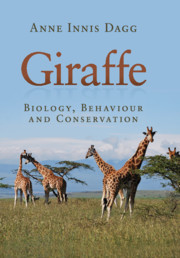Book contents
- Frontmatter
- Dedication
- Contents
- Preface
- Acknowledgements
- List of abbreviations
- 1 Time-line of giraffe
- 2 The giraffe’s environment
- 3 Feeding in the wild
- 4 Social behaviour and populations
- 5 Individual behaviours
- 6 External features
- 7 Anatomy
- 8 Physiology
- 9 Pregnancy, growth, reproduction and aging
- 10 Giraffe in zoos
- 11 Status and conservation of giraffe races
- Appendix Parasites and pathogens
- References
- Index
10 - Giraffe in zoos
Published online by Cambridge University Press: 05 February 2014
- Frontmatter
- Dedication
- Contents
- Preface
- Acknowledgements
- List of abbreviations
- 1 Time-line of giraffe
- 2 The giraffe’s environment
- 3 Feeding in the wild
- 4 Social behaviour and populations
- 5 Individual behaviours
- 6 External features
- 7 Anatomy
- 8 Physiology
- 9 Pregnancy, growth, reproduction and aging
- 10 Giraffe in zoos
- 11 Status and conservation of giraffe races
- Appendix Parasites and pathogens
- References
- Index
Summary
Giraffe are good for zoos because they attract people intrigued by this amazing species. They are bad for giraffe, though, who are used to wide open spaces and a huge quantity of various leaves on which to munch. Fortunately, zoos have basic standards for animal welfare: animals must have freedom from disease, the possibility of reproducing and a long life (Bashaw et al., 2001).
Recently, the importance of psychological welfare has also been advocated which involves the reduction of negative stress, boredom and trauma for animals. Animals in the wild encounter new experiences every day; if possible, they should have similar stimulation in captivity. These standards apply to all species, including giraffe.
To some extent, the health of a giraffe can be estimated from what it looks like. Members of Disney’s Animal Kingdom asked North American facilities holding giraffe to send them digital photos of their animals so they could compare and score them as to body type and conditioning (Christman, 2008). Seventy institutions responded. Seven knowledgeable experts then rated the 100 most clear images on a scale of one to five, one being giraffe in the poorest (emaciated) condition and five the fattest/obese animals. This comparison made it possible for keepers to decide if their own giraffe needed a change in diet or other conditions, which they were urged to undertake cautiously and under the care of a veterinarian. Most obviously, having a thin neck and bony prominences indicate a giraffe in poor condition.
- Type
- Chapter
- Information
- GiraffeBiology, Behaviour and Conservation, pp. 153 - 183Publisher: Cambridge University PressPrint publication year: 2014

